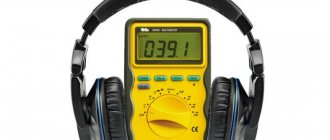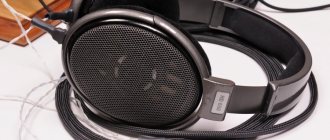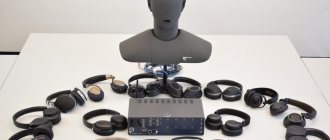The reinforcement emitter in the original is called “balanced armature” and does not have an exact translation. The following names for headphones with this emitter are usually used:
- Armature headphones
- Balanced Armature Headphones
- Headphones with balanced armature
- Balanced fittings
And many other phrases with the words “reinforcement”, “anchor”, “balanced/balanced”. The design of the operation of the reinforcement radiator is so far from dynamic and so little variation among reinforcement radiators that any name is suitable.
The reinforcement emitter looks like a rectangular oblong bottle, where the sound is emitted from the neck. Thus, the radiation axis coincides with the main length, and the width and height of the emitter are relatively small. Thanks to this shape, this type of emitter has become widespread in in-ear hearing aids, where a conventional dynamic emitter cannot be placed in a narrow ear canal.
Marketers from different companies like to compare the dimensions of an armature and dynamic driver, showing that the armature driver is much smaller and plays no worse.
But the laws of physics cannot be fooled, and all the parameters that depend on the dimensions are also valid for an armature driver: small dimensions limit the bass and overload capacity of the driver.
In order for armature headphones to be as good as dynamic headphones in terms of overload capacity in the low-frequency region, it is necessary either to use an armature emitter with comparable dimensions or to use several emitters simultaneously.
Like any driver, armature or dynamic, the type itself is not synonymous with defining quality or mandatory characteristics. There are budget models with mediocre sound, and there are expensive and very expensive ones with high sound quality. It is completely pointless to compare inexpensive armature headphones with expensive dynamic ones and vice versa. Preferences will often be towards an expensive model, regardless of the type of emitter.
Structurally, with the same membrane area for the reinforcement and dynamic emitter, the membrane stroke is greater for the dynamic one. For this reason, dynamic drivers have a higher overload capacity, which is expressed in the absence of crackling sound at high volumes. When the task is to obtain the same bass as a dynamic radiator using a reinforced one, a large total area from the reinforced radiator is required (compensating for the small stroke of the membrane).
An additional disadvantage of many armature drivers is their narrow neck, which adds distortion in the low-frequency region due to the inability to “pump” the required volume of air. The neck is necessary for attaching the sound guide to hearing aids. Probably for this reason, the reinforcement emitters of the SONY company (which does not produce its emitters for hearing aids) do not have a neck.
Development of armature headphones
In the history of the origins of armature headphones, Jerry Harvey played the most prominent role.
At that time, reinforcement emitters were used primarily in hearing aids. If the hearing impaired were only interested in the mid-frequency range (to hear the speech of others) and high volume, then musicians and audiophiles needed a wide frequency range, high overload capacity and the highest possible sound quality. This required a completely different approach.
In 1995, Jerry Harvey created the first custom monitors for musicians, laying the foundation for the development of multi-driver models. Custom monitors were an analogue of a hearing aid with high noise insulation for performing on stage. The case of custom headphones (as well as hearing aids) is made individually according to an ear impression, which ensures a secure fit and the best noise insulation. For musicians, custom monitors are called personal ear monitoring systems.
The use of several emitters made it possible to obtain high sound quality and move away from the level of “hearing aids”. Gradually, successful custom models migrated to universal headphones and are widely used today.
A little earlier, in 1991, Etymoic introduced the ER-4 model (still in high demand among single-driver models). However, the single-driver ER-4 is primarily intended for audiophiles.
Among audiophiles there are many adherents of both single-driver models (no filters and, accordingly, less phase distortion) and multi-driver models (more phase distortion due to filters, but with an advantage in some other parameter: overload capacity, deep raised bass, etc. .P.).
How the device works
The operating principle is as follows. The anchor, attached to the back of the sound membrane, has a U-shape. It can be made of metal or more expensive alloys, which have a softer structure, which contributes to high sound quality.
The main feature of armature headphones is the movement of the armature, which has only an axial direction. When an electromagnetic field occurs, the armature begins to rotate, while acting on an additional element - a lever. The lever is mounted specifically to transmit force to the membrane. The result of such forces on the membrane are sound waves that the user hears.
Because of the armature, reinforcement headphones have the shape of an oblong object, but more modern models can also be flat.
Many drivers and sound quality
Lately, manufacturers have been trying to fit as many reinforcement emitters into an earphone as possible, hinting that the more emitters, the higher the quality. Today, among mass products, the number of drivers reaches 6 pcs. In non-mass and Custom headphones, the number of drivers can reach 12 or more (for example, JH Audio Layla).
Custom headphones with “only” 8 emitters
A large number of emitters does not always improve quality and creates problems with the dimensions of the final headphones, which limits the mass production of headphones with more than 3 emitters. In most cases, with comparable dimensions to a three-driver model, a 6-driver model simply uses smaller armature drivers. For example, the Westone W60 uses 6 emitters, but there are three bands for playback, and two identical emitters are used for each band. The cost with this approach increases not at all in proportion to the quality.
When it comes to Custom models, the ear impression often determines the maximum number of emitters that can be used and which headphone models are automatically excluded.
What is the real use of models with a huge number of drivers?
In concert monitors, due to the large number of emitters, they try to increase the sensitivity of the headphones, which in turn provides loud sound even from weak sources (you never know what kind of equipment you will have to work with on stage).
Usually, if an ordinary user takes concert monitors, he often begins to complain about the good audibility of background noise from the source (for example, a telephone). Most companies developing multi-driver models are focused on musicians, and for this reason you need to be picky when choosing multi-driver headphones - the result does not often coincide with expectations. Most concert monitors are designed to be used in noisy environments and will be perceived by the deaf in less noisy environments. In this case, the transition from traditional models with three emitters does not contribute to the transition to a new level of quality, but only empties your wallet.
For audiophiles, it is necessary to configure the emitters so that they operate in a lightweight mode with a low level of distortion at normal headphone sensitivity.
In addition to the quantity and quality of emitters, the sound is greatly influenced by filters (crossovers), which divide the sound stream into separate frequency ranges. Due to the inability to use inductors and large capacitors, crossover and selection of emitters is a very expensive part of the development and sometimes affects the final quality more than the quality of the emitters individually. Headphones with a large number of emitters and a low price (even if it seems adequate for the total price of components) can be significantly inferior to famous models with a seemingly simpler element base.
As for the choice between Custom and regular headphones with comparable components from the same manufacturer, a custom case usually costs between $200 and $500.
How to choose reinforcement headphones
There are a number of criteria for choosing reinforcement headphones:
- Connection type – armature headphones can be wireless (work via Bluetooth) or wired. If the headset will only be used with a telephone, then wired ones will do. If the range of their use is wider, then it’s worth buying Bluetooth headphones.
- Number of drivers - the more emitters, the wider the range of reproduced frequencies. Moreover, each of the drivers requires crossovers, and their excess will lead to an increase in phase distortion.
- Sensitivity – it affects the volume of the sound. Sensitivity also affects the energy efficiency of the headphones. The higher the decibels in the device, the more economical the battery consumption (in the case of wireless models).
- Controls – Many brands do not build volume buttons into their remote controls. And for comfortable use, their presence is mandatory.
- Microphone – with its help, headphones are used not only for listening to music, but also for conversations.
- Contents – As a rule, the box with budget models includes instructions and 2-3 ear pads. Whereas an expensive headset may include a spare reinforced cable, a set of tools, etc.
There are other selection criteria, but these are the main ones.
Round reinforcement
A separate type of reinforcement emitters is round reinforcement, known to many by the name of the first successful Siren Armature series. The round shape follows the dynamic drivers and competes with them only due to the quality or character of the sound. The main advantage is higher sensitivity and the absence of a neck. Today, with round fittings you can find mainly high-end single-driver models (such as Grado GR8 and GR10). In most cases, headphones with round fittings demonstrate neutral and smooth sound with high detail. Interestingly, Grado GR10 is positioned higher than GR8, although the class of headphones is the same and the models differ in tonal balance, GR8 have a “darker” sound, and GR10 has a “lighter” sound.
If previously single-driver headphones with broadband armature drivers were de facto standard quality for many (Etymoic ER-4, Klipsh X10, etc.), then headphones with round armatures have quite confidently supplanted the leading positions.
Models with inferior radiators of round fittings have not taken root on the market (S-Jays, Fischer Audio SBA-1), because there was no obvious advantage over a traditional balanced armature or speaker. The application for the use of “Siren Armature” as a guarantor of quality did not cause delight among consumers, because there were inflated expectations among different groups. The headphones could not compete with the reinforced Etymoic ER-4 and Klipsh X10 in terms of detail, or with the dynamic models in terms of quality.
Advantages and disadvantages of an armature emitter
Advantages
- Most emitters do not require a separate chamber (equivalent volume). This allows the headphone body to be used in any shape.
- Single-driver armature headphones have a rise in impedance in the high frequency region, which allows you to reduce the level of distortion of the headphone amplifier and get better sound (for example, in the Grado GR8 and GR10).
Flaws
- With equal dimensions of the reinforcement and dynamic radiators, at best there is parity, at worst, the loss of the reinforcement radiator in the low frequency region. An armature radiator can gain an advantage only in a multi-driver system, where a separate driver will be responsible for individual frequency ranges (for example, a small-sized, lightweight one for high frequencies, the largest and heaviest for low frequencies, as in Shure SE425, Ultimate Ears TripleFi 10).
- Low frequencies are the most difficult for armature drivers (low stroke and throat) and, following conventional multi-driver armature headphones, hybrid systems began to appear, where the speaker is responsible for the low-frequency range, and the armature is responsible for the mid and high frequencies (for example, Sony XBA-Z5, AKG K3003, T-PEOS H-100).
The hybrid system requires a separate chamber for the speaker and therefore the ergonomics replicate traditional dynamic models.
Peculiarities
- If for dynamic headphones the resistance value indirectly affects sensitivity to voltage and high-impedance headphones belong to the class of “quiet and unsuitable for portable devices,” then reinforcement headphones do not have such a connection. The resistance can reach up to hundreds of ohms and compete in volume with dynamic headphones with a resistance of 16 ohms.
- For multi-driver armature headphones, the impedance line may have a high spread of peaks and valleys and, accordingly, require a high-quality amplifier to unlock the potential of the headphones. Depending on the nature of the impedances of the headphones and amplifier, the final frequency response of the headphones will change.
What you need to know before you buy
Yes, armature headphones are somewhat more expensive than dynamic ones. The main reason for this inequality is the complex production process. Like any product, headphones with a balanced armature have their advantages and disadvantages, so when choosing headphones of this type, you should pay attention to some of their features:
- Unlike dynamic ones, reinforcement headphones can have a body of the most bizarre shape.
- Fans of low, rich bass should pay attention to the presence of additional volume in the housing, or the presence of additional radiators. In order to ensure a decent level of bass line, hybrid type headphones were developed, in which a traditional speaker is responsible for the low frequencies, and a reinforcement driver reproduces the mids and highs.
- Single-driver models cannot boast of booming, meaty bass.
- Armature headphones are distinguished by a smooth amplitude-frequency response and reproduce sound without the frequency rise characteristic of dynamic emitters in a certain area.
- Fewer drivers have a positive effect on the naturalness and clarity of the sound.
- The resistance of armature headphones has virtually no effect on their sensitivity.
When choosing armature headphones, remember that the high price must have adequate justification, and the preferences of each listener are strictly individual. Comparing traditional dynamic and reinforcement headphones in the same class, we can give a clear description of the latter: reinforcement headphones sound cleaner and more natural, they do not have deep bass and low frequencies, and they are somewhat inferior to dynamic ones when listening in noisy places. For the rest, just listen.
Prepared with information support from Westone .
(
21 votes, overall rating: 4.86 out of 5)











